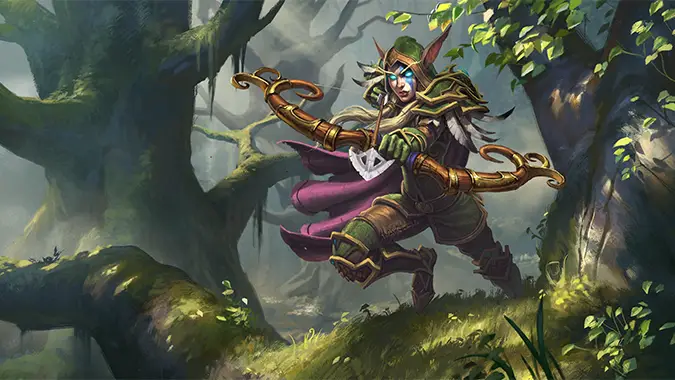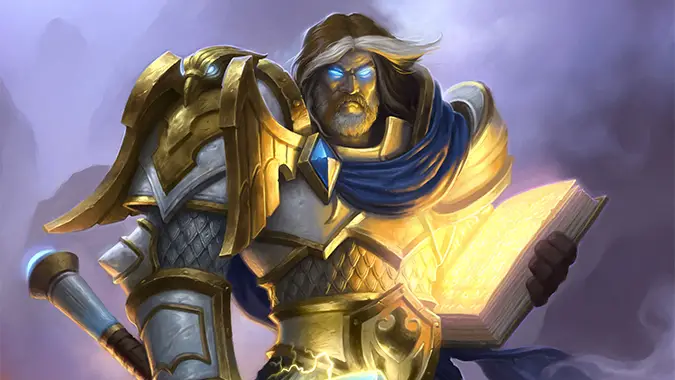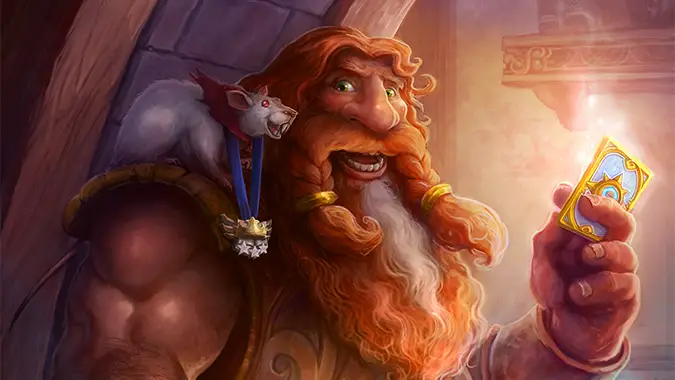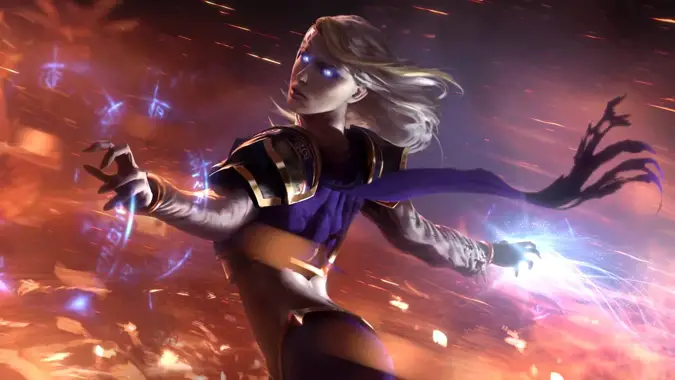Explaining the Win More concept in Hearthstone

One of the skills of an excellent deck builder is the ability to examine and determine how cards can help fit into a deck. In some discussions, you may come across a term that’s commonly thrown out and used to dismiss cards.
“That’s completely a win more card and isn’t really going to help you. Get rid of it.”
Today we’ll go over what “win more” cards are and what that concept means.
It’s a great question and it ties into the concept of evaluating cards. Whenever Hearthstone releases a new adventure or expansion, there’s always new cards that need to be examined to determine their feasibility in constructed or Arena formats.
One of the common examples for a “win more” card I see listed is Bloodlust.
We’re going to take a page from renowned Magic player and theorist Brian Wong to discuss Quadrant Theory. There are four fundamental game states when evaluating cards in a vacuum.
- Opening or Developing. This is the first few opening turns when players don’t have much in the way of mana available to them. The cards being played will either be aggro cards or control oriented cards.
- Parity. Hand sizes have dwindled and most cards have been played. Now they’re playing cards off the top of their deck but neither side has a true advantage and the board has roughly evenly matched.
- Winning. You have a pair of Molten Giants on the board with a Sludge Belcher and a taunted up Ancient Watcher protecting them. With your opponent at 30 health, you will secure a win in two turns if your opponent is unable to mount a successful response.
- Losing. You are on the other end of the previous example. You need a way out and you need it fast or else your game is over.
It is certainly possible for multiple cards to belong into multiple quadrants. Cards aren’t mutually exclusive here. But if you find yourself a card that does not belong in any of the four quadrants, then it is a decidedly bad card. Magma Rager is a perfect example of a bad card that just doesn’t really fit anywhere.
Opening or Developing
- Examples: Mad Scientist, Haunted Creeper, Acolyte of Pain, and Shielded Minibot
Parity
- Examples: Arcane Intellect, Fire Elemental, Ragnaros the Firelord, and Savannah Highmane
Winning
- Examples: Savage Roar, Bloodlust, Soulfire, and Leeroy Jenkins
Losing
- Examples: Sludge Belcher, Flamestrike, Brawl, and Twisted Nether
Returning back to our Bloodlust example, we can see that it actually fits more than one quadrant.
- Developing: Definitely doesn’t belong here. You can’t develop your side of the board with a Bloodlust.
- Parity: If both players have enough minions in play, it’s a stalemate. Bloodlust gives your the opportunity to completely wipe out your opponent’s board or bypass them entirely and go right for their face.
- Winning: Bloodlust allows you to close out the game without giving your opponent a chance to come back.
- Losing: No help here at all since Bloodlust affects minions. Slightly different compared to Savage Roar as that buffs your hero as well.
Bloodlust is great if you happen to have a board full of hero power totems and other smaller minions. It gives all your minions on the board an additional 3 attack power. That Wrath of Air totem just got a whole lot scarier. If you already have a field of totems on the board, you’re in a fairly advantageous position especially if your opponent hasn’t dealt with any of them or doesn’t have anything out that can deal with it.
An actual win more card means that you need to be in a purely winning position for it to be used. A better example of a win more card is something like a warlock’s Summoning Portal.
- Developing: The earliest it can come out is turn 3 with a Coin. Downside is that mana spent on the Summoning Portal is mana not spent on better 3 mana drops because the portal by itself doesn’t allow you to effectively trade against other minions.
- Parity: Assuming it stays on the board the next turn and you have minions in your hand, it could break parity in the game.
- Winning: When you’re ahead, it’ll allow you to cast minions at a much cheaper rate.
- Losing: With little to no minions on the board, the Summoning Portal will almost always get overrun and removed.

A card example that happens to fit multiple quadrants is Tirion Fordring. He’s a bit of a more obvious example and is often a staple stud in many paladin decks. But let’s go through the exercise, shall we?
- Developing: Doesn’t fit here at all. He is an 8 mana bomb and won’t be coming out super early.
- Parity: Definitely breaks parity. He can go toe-to-toe against most minions and live.
- Winning: Tirion will close out the game for you easily if left unchecked. Even if he’s removed, he provides you with a 5 attack weapon that can be used to clear obstructions on the board or used directly against your opponent.
- Losing: He has Divine Shield and a Taunt. Your opponent has to go through him before they can get to you. In most cases, he’ll be able to buy you at least a turn (or take out some enemy minions in the process).
I don’t even need to go into much further detail about how awesome Tirion is in any situation.
Here’s a rather interesting “tech” card we can look at. Tech cards are often referred to as such because they’re valuable under an extremely specific set of circumstances. The Black Knight, Kezan Mystic, and Mind Control Tech are a few examples of tech cards.
- Developing: At 3 mana, he’s okay in the early stage of the game. Thankfully, he comes with 3 health and 3 attack which means he can still hold his own.
- Parity: Pretty decent card who can help you break parity with the potential of a minion swing in your favor. Not only do you get a 3/3, but you could steal one of the opposing minions at random (if there’s a sufficient amount).
- Winning: Nope, he isn’t going to help you win that much harder if you’re already winning. Might as well not even play him.
- Losing: There’s certainly an element of luck here. He can help you out if you’re down but your opponent needs to have enough minions for the battlecry to be effective. He might buy you a few turns at best but he isn’t enough on his own to completely turn around a losing situation.
As you can see, the Mind Control Tech’s use depends largely on what your opponent does. If they overcommit, the Tech’s value goes up. Otherwise, he’s just an average card.

We looked at minions in the previous examples, so let’s cover some spells here. Certain druid cards can be used in one form or it can be used in a different form. Dark Wispers can create 5 Wisp minions or give one minion a really big buff.
- Developing: At 6 mana, you won’t be developing much of a board with those Wisps in the early game. You’d need to draw into a pair of Innervates to play it early.
- Parity: Having a minion with an extra +5/+5 and a taunt breaks up a stalemate quite nicely. Having 5 Wisps isn’t completely terrible either.
- Winning: Offers a little flexibility if you’re already ahead by making an existing minion hit harder or you can spread yourself out a bit so that your big minion doesn’t leave itself vulnerable to a Polymorph.
- Losing: An expensive desperation spell that requires one minion to be truly effective since 5 Wisps won’t exactly hold off an army on the board (although did they a pretty good job against Archimonde in Warcraft 3).
One of the few reasons why Dark Wispers doesn’t quite make the cut in many Druid decks today is that there are simply other better cards that can fit in the 6 mana slot and it doesn’t solve problems that other cards can’t already do. When it comes to figuring out what cards to include in a deck, you want to consider the cards that can adequately fit in most of the quadrants. Look primarily for cards that can help you develop the early game or that can potentially help you break parity. Don’t include too many cards that require you to be behind for them to be useful because you might not even draw them. Keep these concepts in mind the next time you’re advancing through the arena or if you’re looking to jump into ranked play.
With a Hearthstone announcement being teased for July 22, keep these thoughts in mind if the rumors hold true and a new card expansion is being slated for release.
Please consider supporting our Patreon!
Join the Discussion
Blizzard Watch is a safe space for all readers. By leaving comments on this site you agree to follow our commenting and community guidelines.
 @Matticus
@Matticus




